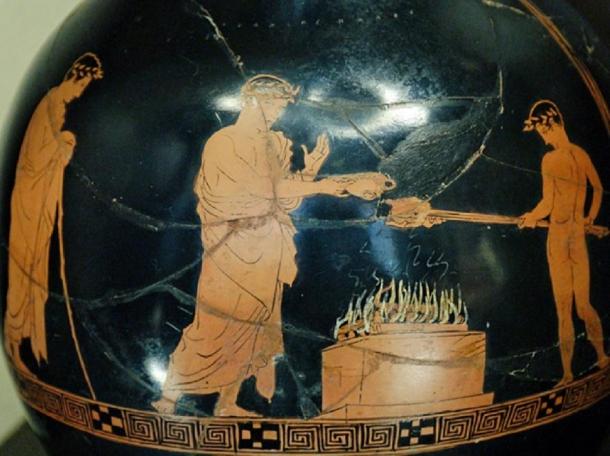
Orphic Masks and Burial Rituals: Unmasking King Philip II of Macedon
That is the gods’ work, spinning threads of death
through the lives of mortal men,
and all to make a song for those to come. Homer
The ancient Greek world was steeped in superstition and deisidaimonia, a ‘sanctimonious piety’. Not only did the gods above need pacifying, but also the daimons below. Thunder was Zeus’ anger, sea storms Poseidon’s wrath, and the dark mood of Demeter was responsible for crop failure and famine, if not a pestilence spread by Apollo.

Wall painting in the royal tomb at Vergina, Macedonia ( CC BY-SA 2.0)
When looking to the sky, comets were considered celestial portents, while eclipses were harbingers of death. Man could do no more in the face of such threats than beseech divine favor, so animals were sacrificed before battle and libations poured into the earth to ensure good fortune at any and every significant event.

Animal sacrifice with libations; depiction ca. 430-425 BC. Louvre. (Public Domain)
But the dialogue with lofty Olympian deities and chthonic gods beneath often went deeper and darker than that, with the more ancient of the mysticisms rooted in atonement, the expulsion of curses, and purification rituals in which tombs and mausoleums played an integral part. Ghosts frequented the subterranean burial chambers where the deceased commenced their journey to the realm of Hades, and they were not to be intruded upon without consequences.
Desecrator’s Guilt
Which is why when the head excavator at Vergina in northern Greece discovered the cluster of four royal tombs and a shrine beneath a great earthen hill in 1977, he carried with him a keen sense of the ‘desecrators’ guilt’. The emotion was made more poignant when the artifacts from unlooted Tombs II and III were dated to the mid-to-late fourth century BC: he was trespassing in chambers buried and sealed in the era of King Philip II of Macedon and his son, Alexander the Great.

Arial view of the ruins of ancient Aegae showing the palace and theatre. (Image: © David Grant 2019)
Thirty-five years later, an anthropological team studying the bones from what had proved to be the location of ancient Aegae, the burial ground of kings, found evidence of these ancient death rituals.
Tomb II was the scene of a unique double burial: in two never-before-seen gold ossuary chests lay the cremated remains of a male and female, positioned in each of the tomb’s two chambers.
Like this Preview and want to read on? You can! JOIN US THERE ( with easy, instant access ) and see what you’re missing!! All Premium articles are available in full, with immediate access.
For the price of a cup of coffee, you get this and all the other great benefits at Ancient Origins Premium. And - each time you support AO Premium, you support independent thought and writing.
David Grant is author of Unearthing the Family of Alexander the Great, the Remarkable Discovery of the Royal Tombs of Macedon available at amazon.com.
Top Image: Remains from the funerary pyre of Philip II. (Macedonian Heritage / CC BY-SA 3.0)
By David Grant















